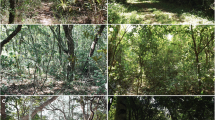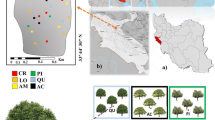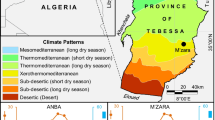Abstract
The integration of mineral element composition was compared in two tree species of contrasting ecology. The native Prosopis cineraria is slow growing and non-invasive, while the introduced P. juliflora is fast growing, highly aggressive and invasive, and causes substratum degradation in the semi-arid and arid areas of north and north-west India. The two species were sampled from 18 sites in this region. Their leaf samples were analysed for leaflet weight, area and leaflet specific weight, and ash, Ca, Mg, Na, K, Zn, Cu and P concentrations. The soil samples were analysed for pH, electrical conductivity, exchangeable Ca, Mg, Na, K, Zn, PO$_4$, HCO$_3$, and organic carbon contents. Analysis of the data showed that while P. cineraria exhibited numerous correlations amongst plant and soil characteristics, it was not so in P. juliflora. This lack of integration amongst plant and soil characteristics and the ability to meet its nutrient requirements in all situations could be the basis of the phenomenal spread of P. juliflora across varying environmental conditions, in contrast to P. cineraria. This study illustrates the use of such information in the assessment of the ecological success of plant species, especially its evaluation in alien environments.
Similar content being viewed by others
References
Aber, J. D. 1987. Restored forests and the identification of critical factors in species-site interactions. Pp. 241-250. In: Jordan, W. R. III, Gilpin, M. E. & Aber, J. D. (eds.) Restoration Ecology: A Synthetic Approach to Ecological Research. Cambridge University Press, Cambridge.
Allen, S. E. 1989. Chemical Analysis of Ecological Materials (2nd ed.). Blackwell Scientific Publications, Oxford.
Berg, R. L. 1960. The ecological significance of correlation pleiades. Evolution 14: 171–180.
Black, C. A. 1968. Soil-Plant Relationships (2nd ed.). John Wiley and Sons, New York.
Boerner, R. E. J. 1984. Foliar nutrient dynamics and nutrient use ef-ficiency of four deciduous tree species in relation to soil fertility. J. Appl. Ecol. 21: 1029–1040.
Brady, N. C. 1990. The Nature and Properties of Soils (10th ed.). Macmillan Publishing Company, New York.
Capone, T. A. & Kushlan, J. A. 1991. Fish community structure in dry-season stream pools. Ecology 72: 983-992.
Chabot, B. F. & Hicks, D. J. 1982. The ecology of leaf life spans. Ann. Rev. Ecol. Syst. 13: 229-259.
Chapin, F. S. III. 1980. The mineral nutrition of wild plants. Ann. Rev. Ecol. Syst. 11: 233-260.
D’ Antonio, C. M. 1993. Mechanisms controlling invasion of coastal plant communities by the alien succulent Carpobrotus edulis.Ecology 74: 83-95.
El-Ghonemy, Wallace, A. & Romney, E. M. 1978. Nutrient concentrations in the natural vegetation of the Mojave desert. Soil Sci. 126: 219-229.
Field, C. and Mooney, H. A. 1986. The photosynthesis - nitrogen relationship in wild plants. Pp. 25-55. In: Givnish, T. J. (ed.), On the Economy of Plant Form and Function. Cambridge University Press, Cambridge.
Garten, C. T. Jr. 1976. Correlations between concentrations of elements in plants. Nature 261: 686-688.
Garten, C. T. Jr. 1978. Multivariate perspectives on the ecology of plant mineral element composition. Am. Nat. 112: 533-544.
Hobbie, S. E. 1992. Effects of plant species on nutrient cycling. Tree 7: 336-339.
Inderjit and Dakshini, K. M. M. 1994. Allelopathic effect of Pluchea lanceolata(Asteraceae) on characteristics of four soils and tomato and mustard growth. Am. J. Bot. 81: 799-804.
Piper, C. S. 1966. Soil and Plant Analysis. Hans Publishers, Bombay.
Roth, I. 1992. Leaf Structure: Coastal Vegetation and Mangroves of Venezuela. Gebrüder Borntraeger, Berlin.
Schlichting, C. D. 1989. Phenotypic integration and environmental change. Bioscience 39: 460-464.
Sharma, R. 1993. An ecological assessment of the native Prosopis cineraria(L.)Druce and the alien P. juliflora(Sw.)DC. (Leguminosae Subfam. Mimosoideae) Ph.D. thesis, University of Delhi, India.
Sharma, R. & Dakshini, K. M. M. 1991. A comparative assessment of the ecological effects of Prosopis cinerariaand P. julifloraon the soil of revegetated spaces. Vegetatio 96: 87-96.
Sharma, R. & Dakshini, K. M. M. 1996. Ecological implications of seed characteristics of the native Prosopis cinerariaand the alien P. juliflora. Vegetatio 124: 101-105.
Solbrig, O. T. 1979. Life forms and vegetation patterns in desert regions. Pp. 82-95. in Goodin, J. R. & Northington, D. K. (eds.) Arid Land Plant Resources. International Center for Arid and Semi-Arid Land Studies, Texas.
SPSS PC 1986. Advanced Statistics: SPSS/PC + McGraw-Hill, Chicago.
Thébaud, C., Finzi, A. C., Affre, L., Debussche, M. & Escare, J. 1996. Assessing why two introduced Conyzadiffer in their ability to invade Mediterranean old fields. Ecology 77: 791-804.
Tiedemann, A. R. & Klemmedson, J. O. 1973. Effect of mesquite on physical and chemical properties of the soil. J. Range Management 26: 27-29.
Vitousek, P. 1982. Nutrient cycling and nutrient use efficiency. Am. Nat. 119: 553-572.
Williams, B. K. 1983. Some observations on the use of discriminant analysis in ecology. Ecology 64: 1283-1291.
Author information
Authors and Affiliations
Rights and permissions
About this article
Cite this article
Sharma, R., Dakshini, K.M.M. Integration of plant and soil characteristics and the ecological success of two shape Prosopis species. Plant Ecology 139, 63–69 (1998). https://doi.org/10.1023/A:1009767503906
Issue Date:
DOI: https://doi.org/10.1023/A:1009767503906




